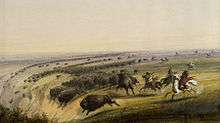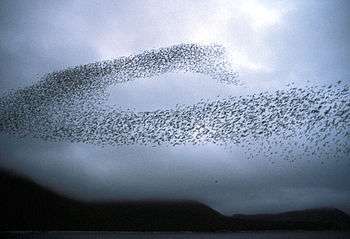Pack hunter
.jpg)
A pack hunter or social predator is a predator belonging to the animal kingdom which hunts its prey by working together with other members of its species. Normally animals hunting in this way are closely related, and with the exceptions of humans and chimpanzees where only males normally hunt, all individuals in a family group contribute to hunting.
The most commonly known pack hunter is the gray wolf, the closest wild relative of all breeds of domesticated dog. Humans can be considered pack hunters as well. Other pack hunting mammals include chimpanzees, dolphins, lions, dwarf and banded mongooses and spotted hyenas. Aavian social predators include the Harris's hawk, butcherbirds, three of four kookaburra species and many helmetshrikes. There are a few cold-blooded pack hunters including simple arthropods such as army ants, the yellow saddle goatfish[1] and occasionally crocodiles.[2]
Some non-avian theropod dinosaurs may have displayed pack behavior.[3][4][5]
Pack hunting is typically associated with cooperative breeding and its concentration in the Afrotropical Region is a reflection of this.[6] Most pack hunters are found in the southern African savannas, with a notable absence in tropical rainforests and with the exception of the wolf and coyote, higher latitudes.[6] It is thought that either on the ancient and poor soils of the southern African savanna it is not possible for individual predators to find adequate food,[7] or that the environment’s inherent unpredictability due to ENSO or IOD events means that in very bad conditions it will not be possible to raise the young necessary to prevent declining populations from adult mortality. It is also argued that Africa’s very large area of continuous flat and open country, which was even more extensive while rainforest contracted during glacial periods of the Quaternary, may have helped encourage pack hunting to become much more common than on any other continent.[8]
A shared pack hunting history is thought to be the main conduit through which humans formed a mutual relationship with dogs (that is, domestication), as both species are highly social and inter-dependent. Humans easily take over the dominance hierarchy of dogs as subordinates instinctively follow the “alpha” individual and dogs are accustomed to living very close together[9]

When wolves hunt a moose or elk, it sometimes takes to deep water to avoid the pack. A wolf response to this behavior is that the pack rests with one or two wolves annoying the prey until it gets fatigued.[10]
See also
References
- ↑ Strübin, Carine; Steinegger, Marc; Bshary, Redouan (2011). "On Group Living and Collaborative Hunting in the Yellow Saddle Goatfish (Parupeneus cyclostomus)". Ethology. 117 (11): 961–969. doi:10.1111/j.1439-0310.2011.01966.x.
- ↑ http://www.flmnh.ufl.edu/herpetology/herpbiology/bartram.htm
- ↑ Li, R.; Lockley, M. G.; Makovicky, P. J.; et al. (March 2008). "Behavioral and faunal implications of Early Cretaceous deinonychosaur trackways from China". Naturwissenschaften. 95: 185–191. doi:10.1007/s00114-007-0310-7. PMID 17952398.
- ↑ https://academia.edu/235413/Behavioral_and_faunal_implications_of_Early_Cretaceous_deinonychosaur_trackways_from_China
- ↑ Mudroch, A.; Richter, U.; Joger, U.; Kosma, R.; Idé, O.; Maga, A. "Didactyl Tracks of Paravian Theropods (Maniraptora) from the ?Middle Jurassic of Africa". PLoS ONE. 6: e14642. doi:10.1371/journal.pone.0014642. PMC 3038851. PMID 21339816.
- 1 2 For a brief explanation see Rubenstein, Dustin R.; Lovette, Irby J. "Temporal Environmental Variability Drives the Evolution of Cooperative Breeding in Birds". Current Biology. 17: 1414–1419. doi:10.1016/j.cub.2007.07.032. PMID 17702577.
- ↑ See McMahon T. A. and Finlayson, B.; Global Runoff: Continental Comparisons of Annual Flows and Peak Discharges ISBN 3-923381-27-1
- ↑ Box, Hilary O. and Gibson, Kathleen R. (editors); Mammalian Social Learning: Comparative and Ecological Perspectives, Issue 72; p. 266. ISBN 9780521031950
- ↑ Diamond, Jared; Guns, Germs, and Steel: The Fates of Human Societies; p. 155. ISBN 0393317552
- ↑ WolfCountry.net

